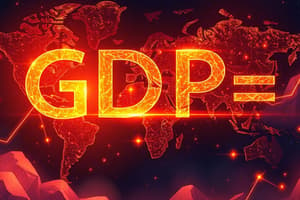Podcast
Questions and Answers
Why do different bonds with the same term of maturity earn different interest rates?
Why do different bonds with the same term of maturity earn different interest rates?
- Because of liquidity
- As a result of administration/information costs
- Due to taxation
- Due to default risk (correct)
What is the term used for the spread between the interest rates on bonds with default risk and those without default risk?
What is the term used for the spread between the interest rates on bonds with default risk and those without default risk?
- Risk spread
- Interest difference
- Default gap
- Risk premium (correct)
Which type of bonds are referred to as default-free bonds?
Which type of bonds are referred to as default-free bonds?
- Government bonds (correct)
- High-yield bonds
- Corporate bonds
- Municipal bonds
What does default risk refer to in the context of bond investments?
What does default risk refer to in the context of bond investments?
What factor ensures that treasury bonds are considered to have no default risk?
What factor ensures that treasury bonds are considered to have no default risk?
According to the text, what influences interest rates and makes treasury bonds (TB) more desirable than corporate bonds (CB)?
According to the text, what influences interest rates and makes treasury bonds (TB) more desirable than corporate bonds (CB)?
How does the Pure Expectations Theory explain the term structure of interest rates?
How does the Pure Expectations Theory explain the term structure of interest rates?
What can cause a yield curve to slope upward according to the Pure Expectations Theory?
What can cause a yield curve to slope upward according to the Pure Expectations Theory?
What influences the interest rate on municipal bonds (MB) relative to treasury bonds (TB) as mentioned in the text?
What influences the interest rate on municipal bonds (MB) relative to treasury bonds (TB) as mentioned in the text?
What causes an increase in the liquidity premium of corporate bonds (CB) according to the information provided?
What causes an increase in the liquidity premium of corporate bonds (CB) according to the information provided?
According to the Segmented Market Theory, why does the yield curve always slope upward?
According to the Segmented Market Theory, why does the yield curve always slope upward?
What is the key assumption of the Liquidity Premium Theory and Preferred Habitat Theories?
What is the key assumption of the Liquidity Premium Theory and Preferred Habitat Theories?
Why do yield curves typically slope upward according to the Liquidity Premium Theory and Preferred Habitat Theories?
Why do yield curves typically slope upward according to the Liquidity Premium Theory and Preferred Habitat Theories?
What is one of the uses of the yield curve?
What is one of the uses of the yield curve?
What does the Segmented Market Theory explain about the relationship between bonds with differing maturities?
What does the Segmented Market Theory explain about the relationship between bonds with differing maturities?
Flashcards are hidden until you start studying
Study Notes
Bond Interest Rates and Risk
- Different bonds with the same term of maturity earn different interest rates due to varying levels of default risk.
- The spread between the interest rates on bonds with default risk and those without default risk is known as the default risk premium.
Default-Free Bonds
- Treasury bonds are referred to as default-free bonds because they are backed by the credit and taxing power of the government.
- The full faith and credit of the government ensures that treasury bonds are considered to have no default risk.
Factors Influencing Interest Rates
- Default risk is a key factor that influences interest rates, making treasury bonds more desirable than corporate bonds.
- The liquidity premium, which is the extra return required for holding less liquid bonds, also influences interest rates.
The Pure Expectations Theory
- The Pure Expectations Theory explains the term structure of interest rates, which is the relationship between interest rates and bond maturities.
- According to the theory, an upward-sloping yield curve is caused by expectations of rising interest rates in the future.
Municipal Bonds
- The interest rate on municipal bonds is influenced by their tax-exempt status, which makes them more attractive to investors and reduces their interest rate relative to treasury bonds.
Corporate Bonds
- An increase in the liquidity premium of corporate bonds is caused by a decrease in their liquidity, making them less attractive to investors.
Theories of the Yield Curve
- The Segmented Market Theory assumes that the yield curve always slopes upward due to the separate markets for different bond maturities.
- The Liquidity Premium Theory and Preferred Habitat Theories assume that investors demand a liquidity premium for holding less liquid bonds, leading to an upward-sloping yield curve.
- The key assumption of these theories is that investors are not willing to hold bonds with different maturities unless they are compensated with a higher return.
Uses of the Yield Curve
- One of the uses of the yield curve is to forecast future interest rates and economic conditions.
- The Segmented Market Theory explains that the yield curve reflects the relationship between bonds with differing maturities, which are determined by separate market conditions.
Studying That Suits You
Use AI to generate personalized quizzes and flashcards to suit your learning preferences.



